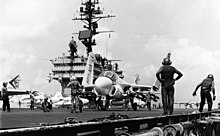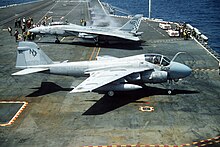
Sea Control Squadron 21 (VS-21) was an aviation unit of the United States Navy. It served from 1945 to 2005 and was mainly tasked with anti-submarine warfare while operating from aircraft carriers. It was the only squadron to receive the designations VA-1E, VC-21, or VS-21.

Strike Fighter Squadron 25 (VFA-25) is an aviation unit of the United States Navy based at Naval Air Station Lemoore, California. The squadron flies the Boeing F/A-18E Super Hornet and is currently assigned to Carrier Air Wing 11. Its callsign is Fist.
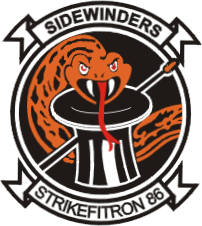
Strike Fighter Squadron 86 (VFA-86) is a strike fighter squadron of the United States Navy based at Naval Air Station Lemoore, California. The squadron is nicknamed Sidewinders, leading to the call sign Winder. The unit currently flies the F/A-18E Super Hornet and is assigned to Carrier Air Wing Seven, tail code AG.

Strike Fighter Squadron 147 (VFA-147), also known as the "Argonauts," is a United States Navy strike fighter squadron based at Naval Air Station Lemoore, California (USA). VFA-147 was established on 1 February 1967 and flies the F-35C Lightning II, becoming the first non-training F-35 squadron in the U.S. Navy.
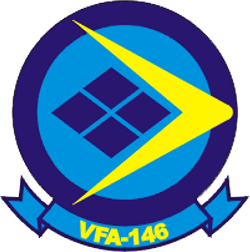
Strike Fighter Squadron 146 (VFA-146) also known as the "Blue Diamonds" is a United States Navy operational fleet strike fighter squadron based at Naval Air Station Lemoore California. They fly the F/A-18E Super Hornet and are attached to Carrier Air Wing 17, deployed aboard USS Nimitz. Their tailcode is NA and their radio callsign is Diamond.

Strike Fighter Squadron 154 (VFA-154), also known as the "Black Knights", is a United States Navy strike fighter squadron stationed at Naval Air Station Lemoore. The Black Knights are an operational fleet squadron flying the F/A-18F Super Hornet. They are currently attached to Carrier Air Wing Eleven and deployed aboard the aircraft carrier USS Theodore Roosevelt. Their tailcode is NH and their callsign is "Knight".
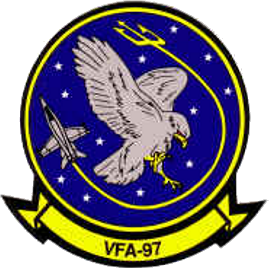
Strike Fighter Squadron 97 (VFA-97) is a naval aviation squadron of the United States Navy. It is equipped with the F-35C Lightning II and is stationed at Naval Air Station Lemoore. The squadron is nicknamed "Warhawks" and it is currently assigned to Carrier Air Wing Two, tail code "NE”. The squadron was originally established as Attack Squadron 97 (VA-97) on 1 June 1967 and redesignated VFA-97 on 24 January 1991.

Strike Fighter Squadron 115 (VFA-115) is known as the "Eagles", callsign "Talon", a United States Navy F/A-18E Super Hornet strike fighter squadron stationed at Marine Corps Air Station Iwakuni. Their tail code is NF. It was established as Torpedo Squadron VT-11 on 10 October 1942, redesignated VA-12A on 15 November 1946, VA-115 on 15 July 1948, then finally VFA-115.
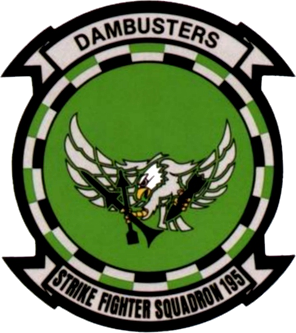
Strike Fighter Squadron 195 (VFA-195), also known as the "Dambusters", is a United States Navy F/A-18E Super Hornet fighter squadron stationed at Marine Corps Air Station Iwakuni, Japan. They are a part of Carrier Air Wing Five (CVW-5) and their tail code is NF. Their radio callsign is "Chippy".

Strike Fighter Squadron 34 (VFA-34), also known as the "Blue Blasters", is a United States Navy F/A-18E Super Hornet strike fighter squadron stationed at Naval Air Station Oceana. They are a part of Carrier Air Wing 11 and are attached to the aircraft carrier USS Theodore Roosevelt. Their tail code is NH and their radio call sign is "Joker".

Strike Fighter Squadron 81 (VFA-81), also known as the "Sunliners", is a United States Navy F/A-18E Super Hornet strike fighter squadron stationed at Naval Air Station Oceana. They are a part of Carrier Air Wing One, their radio callsign is Inferno, and their tail code is AB. Their mission is to conduct prompt and sustained combat operations from the sea. The squadron was originally designated VA-66 on 1 July 1955, was redesignated VF-81 the same day, redesignated VA-81 on 1 July 1959, and finally redesignated VFA-81 on 4 February 1988.

Strike Fighter Squadron 192 (VFA-192), also known as the "World Famous Golden Dragons", are a United States Navy F/A-18E Super Hornet fighter squadron stationed at NAS Lemoore.

Carrier Air Wing Eleven (CVW-11) is a United States Navy aircraft carrier air wing based at Naval Air Station Lemoore, California. The air wing is attached to the aircraft carrier USS Theodore Roosevelt.

Carrier Airborne Early Warning Squadron 112 (VAW-112) is an inactive United States Navy squadron. It was nicknamed the "Golden Hawks". VAW-112 flew the E-2C Hawkeye out of NAS Point Mugu and last deployed as part of Carrier Air Wing 9 (CVW-9) on board USS John C. Stennis.

VA-52 was an Attack Squadron of the U.S. Navy. It was established as U.S. Navy Reserve Fighter Squadron VF-884 on 1 November 1949, and called to active duty on 20 July 1950. It was redesignated VF-144 on 4 February 1953, and VA-52 on 23 February 1959. The squadron was nicknamed the Bitter Birds from about 1951–1953, and the Knightriders from about 1960 onward. Its insignia evolved through several versions and variations from 1951 to the 1980s. VA-52 was decommissioned on 31 March 1995.

Attack Squadron 145 (VA-145) was an aviation unit of the United States Navy, nicknamed the Rustlers from 1951-1954, and the Swordsmen thereafter. The squadron was established as Reserve squadron VA-702 on 1 December 1949, and called to active duty on 20 July 1950. It was redesignated VA-145 on 4 February 1953, and disestablished on 1 October 1993.

Attack Squadron 155 or VA-155 was an 'Attack Squadron of the U.S. Navy. It was established as Reserve Attack Squadron VA-71E in 1946, redesignated as VA-58A on 1 October 1948, and redesignated Reserve Composite Squadron VC-722 on 1 November 1949. The squadron was redesignated as VA-728 on 1 April 1950, and called to active duty on 1 February 1951. It was ultimately redesignated VA-155 on 4 February 1953, and disestablished on 30 September 1977. Its nickname was Silver Fox from the early 1960s onward. It was the second squadron to be named VA-155, the first VA-155 was disestablished on 30 November 1949, while a third VA-155 was established on 1 September 1987 and disestablished on 30 April 1993.
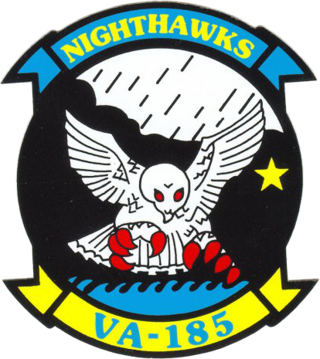
VA-185, nicknamed the Nighthawks, was an Attack Squadron of the U.S. Navy. It was established on 1 December 1986 and disestablished on 30 August 1991.

Attack Squadron 196 (VA-196) was an aviation unit of the United States Navy. It was established as Fighter Squadron 153 (VF-153) on 15 July 1948, redesignated as VF-194 on 15 February 1950, and finally redesignated VA-196 on 4 May 1955. Its nicknames were the Thundercats from 1948 to the 1950s, and The Main Battery from the 1950s thereafter. Beginning in 1979 the squadron used the nickname Milestones interchangeably with Main Battery. The squadron was disestablished on 21 March 1997, after more than 48 years of service.

Attack Squadron 15 (VA-15), nicknamed the Valions, was an aviation unit of the United States Navy. It was established as Torpedo Squadron 4 (VT-4) on 10 January 1942, redesignated VA-2A on 15 November 1946, and finally redesignated VA-15 on 2 August 1948. The squadron was disestablished on 1 June 1969, after 27 years of service.


